Analysis of Fake News in Social and Cultural Interactive Digital Media
VerifiedAdded on 2023/03/17
|14
|4387
|29
Report
AI Summary
This report delves into the multifaceted issue of fake news within the context of interactive digital media. It begins by defining fake news and tracing its historical roots, highlighting instances of misinformation from the 19th century to the present day, including the role of yellow journalism and the rise of social media. The report examines the evolution of fake news, from ancient Rome's smear campaigns to the modern weaponization of information through social media platforms. It analyzes the impact of fake news on society, emphasizing the erosion of trust, the spread of disinformation, and the challenges faced by journalism in an era of rapid technological advancements. Furthermore, it explores the effects of fake news on media and technology companies, including the shift in business models and the decline of traditional journalism. The report also discusses strategies for mitigating the spread of fake news, such as fact-checking and algorithmic interventions, while acknowledging the limitations of these approaches. The report concludes by emphasizing the need for a more reliable and objective source for news.
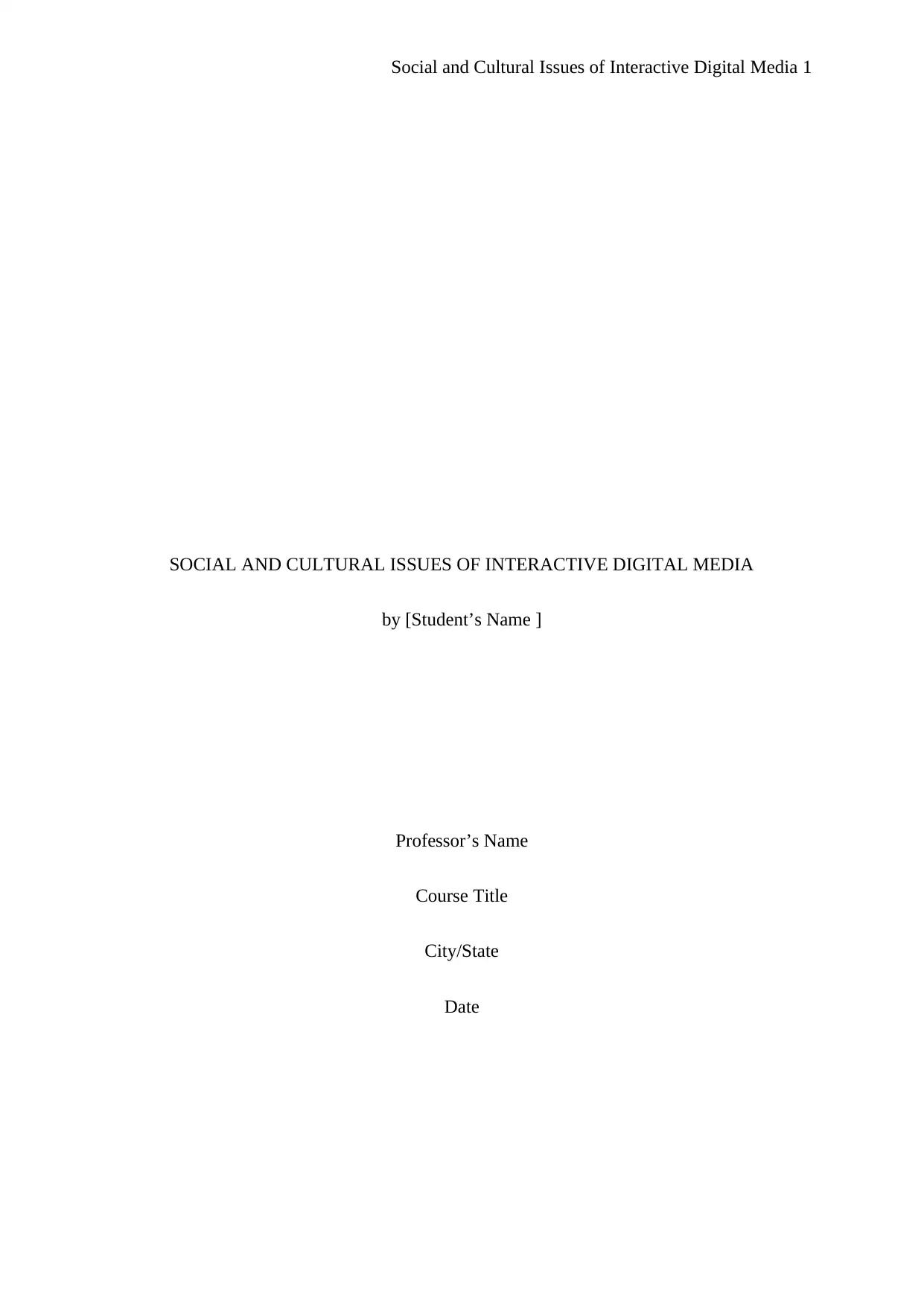
Social and Cultural Issues of Interactive Digital Media 1
SOCIAL AND CULTURAL ISSUES OF INTERACTIVE DIGITAL MEDIA
by [Student’s Name ]
Professor’s Name
Course Title
City/State
Date
SOCIAL AND CULTURAL ISSUES OF INTERACTIVE DIGITAL MEDIA
by [Student’s Name ]
Professor’s Name
Course Title
City/State
Date
Paraphrase This Document
Need a fresh take? Get an instant paraphrase of this document with our AI Paraphraser
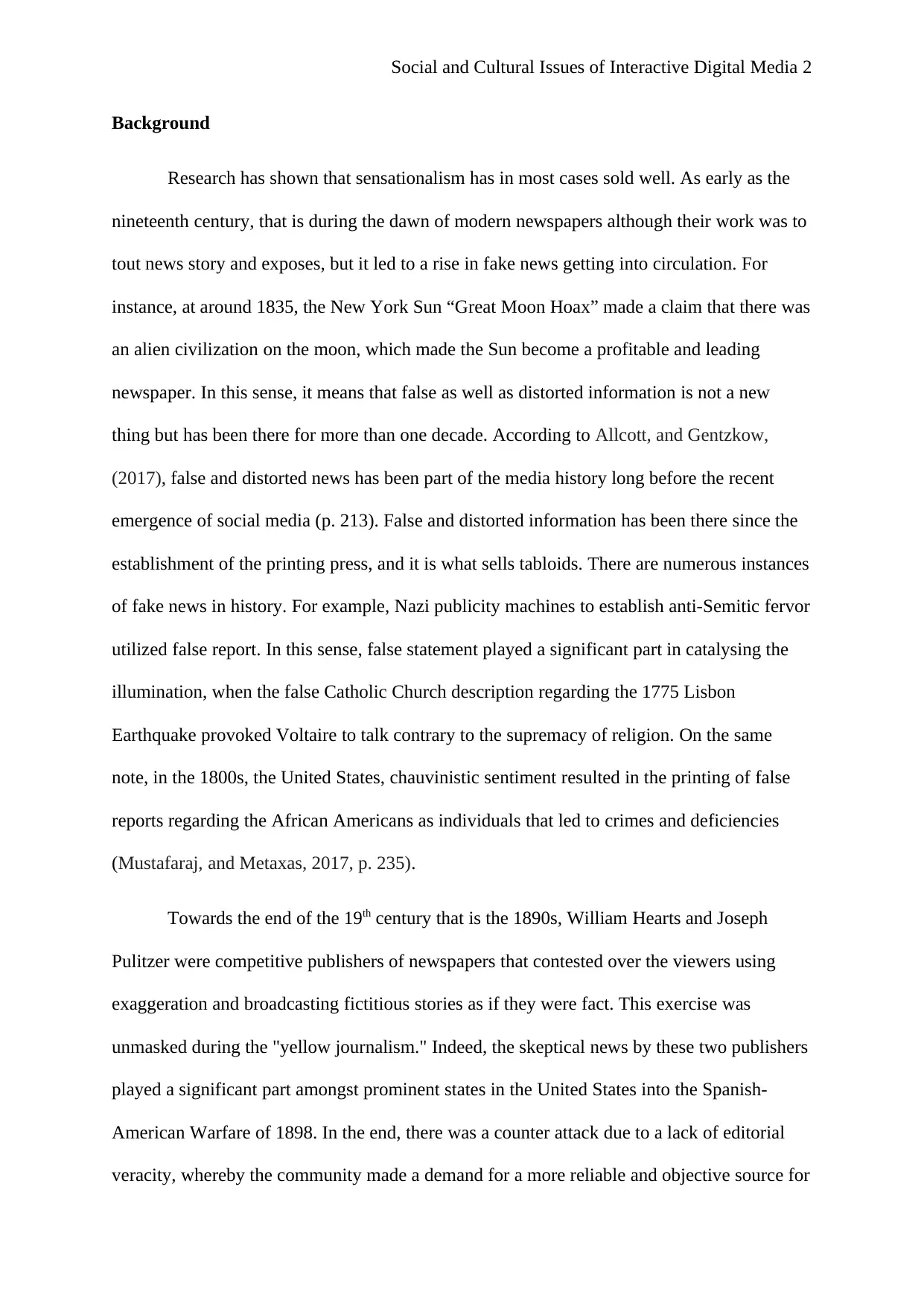
Social and Cultural Issues of Interactive Digital Media 2
Background
Research has shown that sensationalism has in most cases sold well. As early as the
nineteenth century, that is during the dawn of modern newspapers although their work was to
tout news story and exposes, but it led to a rise in fake news getting into circulation. For
instance, at around 1835, the New York Sun “Great Moon Hoax” made a claim that there was
an alien civilization on the moon, which made the Sun become a profitable and leading
newspaper. In this sense, it means that false as well as distorted information is not a new
thing but has been there for more than one decade. According to Allcott, and Gentzkow,
(2017), false and distorted news has been part of the media history long before the recent
emergence of social media (p. 213). False and distorted information has been there since the
establishment of the printing press, and it is what sells tabloids. There are numerous instances
of fake news in history. For example, Nazi publicity machines to establish anti-Semitic fervor
utilized false report. In this sense, false statement played a significant part in catalysing the
illumination, when the false Catholic Church description regarding the 1775 Lisbon
Earthquake provoked Voltaire to talk contrary to the supremacy of religion. On the same
note, in the 1800s, the United States, chauvinistic sentiment resulted in the printing of false
reports regarding the African Americans as individuals that led to crimes and deficiencies
(Mustafaraj, and Metaxas, 2017, p. 235).
Towards the end of the 19th century that is the 1890s, William Hearts and Joseph
Pulitzer were competitive publishers of newspapers that contested over the viewers using
exaggeration and broadcasting fictitious stories as if they were fact. This exercise was
unmasked during the "yellow journalism." Indeed, the skeptical news by these two publishers
played a significant part amongst prominent states in the United States into the Spanish-
American Warfare of 1898. In the end, there was a counter attack due to a lack of editorial
veracity, whereby the community made a demand for a more reliable and objective source for
Background
Research has shown that sensationalism has in most cases sold well. As early as the
nineteenth century, that is during the dawn of modern newspapers although their work was to
tout news story and exposes, but it led to a rise in fake news getting into circulation. For
instance, at around 1835, the New York Sun “Great Moon Hoax” made a claim that there was
an alien civilization on the moon, which made the Sun become a profitable and leading
newspaper. In this sense, it means that false as well as distorted information is not a new
thing but has been there for more than one decade. According to Allcott, and Gentzkow,
(2017), false and distorted news has been part of the media history long before the recent
emergence of social media (p. 213). False and distorted information has been there since the
establishment of the printing press, and it is what sells tabloids. There are numerous instances
of fake news in history. For example, Nazi publicity machines to establish anti-Semitic fervor
utilized false report. In this sense, false statement played a significant part in catalysing the
illumination, when the false Catholic Church description regarding the 1775 Lisbon
Earthquake provoked Voltaire to talk contrary to the supremacy of religion. On the same
note, in the 1800s, the United States, chauvinistic sentiment resulted in the printing of false
reports regarding the African Americans as individuals that led to crimes and deficiencies
(Mustafaraj, and Metaxas, 2017, p. 235).
Towards the end of the 19th century that is the 1890s, William Hearts and Joseph
Pulitzer were competitive publishers of newspapers that contested over the viewers using
exaggeration and broadcasting fictitious stories as if they were fact. This exercise was
unmasked during the "yellow journalism." Indeed, the skeptical news by these two publishers
played a significant part amongst prominent states in the United States into the Spanish-
American Warfare of 1898. In the end, there was a counter attack due to a lack of editorial
veracity, whereby the community made a demand for a more reliable and objective source for
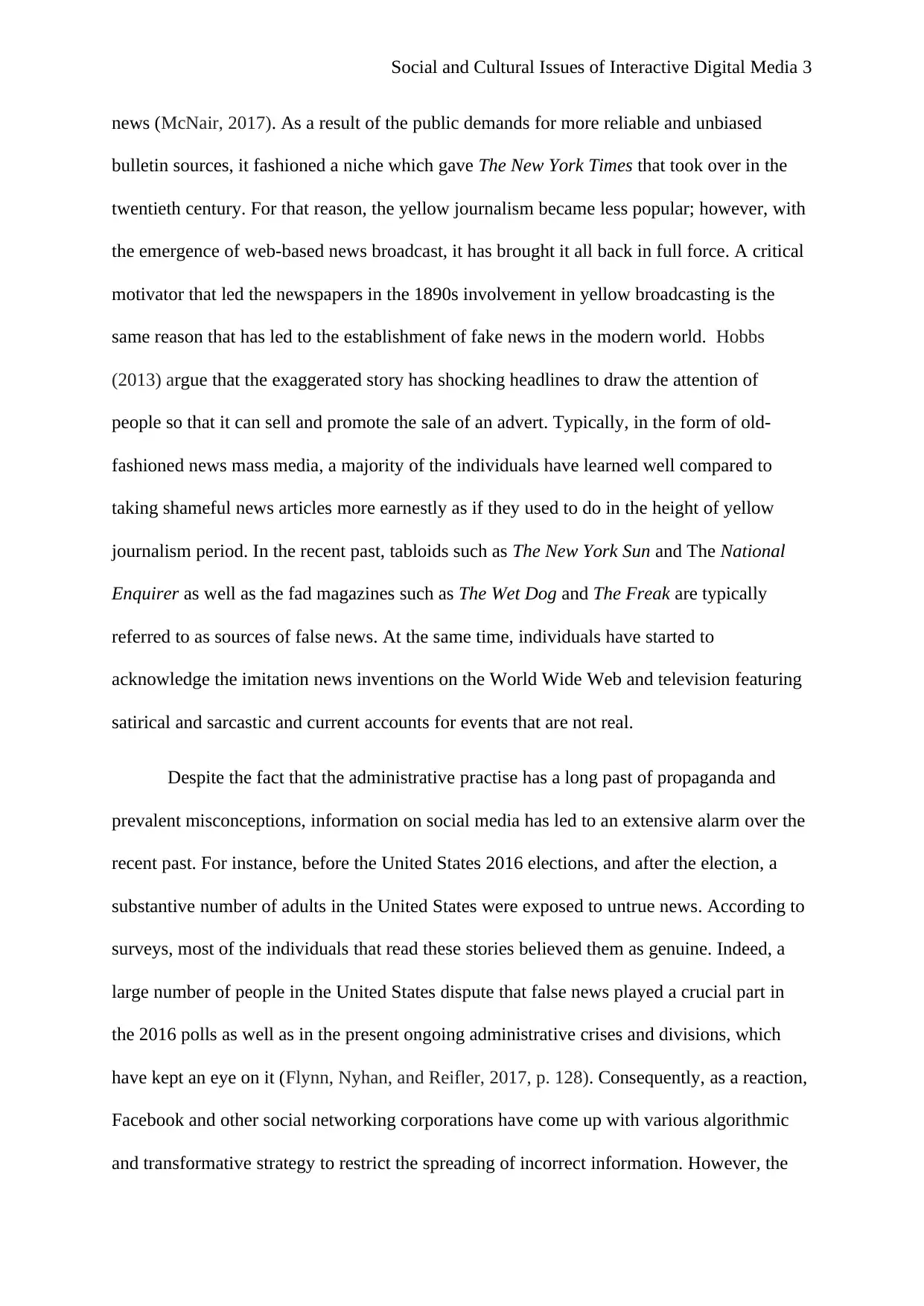
Social and Cultural Issues of Interactive Digital Media 3
news (McNair, 2017). As a result of the public demands for more reliable and unbiased
bulletin sources, it fashioned a niche which gave The New York Times that took over in the
twentieth century. For that reason, the yellow journalism became less popular; however, with
the emergence of web-based news broadcast, it has brought it all back in full force. A critical
motivator that led the newspapers in the 1890s involvement in yellow broadcasting is the
same reason that has led to the establishment of fake news in the modern world. Hobbs
(2013) argue that the exaggerated story has shocking headlines to draw the attention of
people so that it can sell and promote the sale of an advert. Typically, in the form of old-
fashioned news mass media, a majority of the individuals have learned well compared to
taking shameful news articles more earnestly as if they used to do in the height of yellow
journalism period. In the recent past, tabloids such as The New York Sun and The National
Enquirer as well as the fad magazines such as The Wet Dog and The Freak are typically
referred to as sources of false news. At the same time, individuals have started to
acknowledge the imitation news inventions on the World Wide Web and television featuring
satirical and sarcastic and current accounts for events that are not real.
Despite the fact that the administrative practise has a long past of propaganda and
prevalent misconceptions, information on social media has led to an extensive alarm over the
recent past. For instance, before the United States 2016 elections, and after the election, a
substantive number of adults in the United States were exposed to untrue news. According to
surveys, most of the individuals that read these stories believed them as genuine. Indeed, a
large number of people in the United States dispute that false news played a crucial part in
the 2016 polls as well as in the present ongoing administrative crises and divisions, which
have kept an eye on it (Flynn, Nyhan, and Reifler, 2017, p. 128). Consequently, as a reaction,
Facebook and other social networking corporations have come up with various algorithmic
and transformative strategy to restrict the spreading of incorrect information. However, the
news (McNair, 2017). As a result of the public demands for more reliable and unbiased
bulletin sources, it fashioned a niche which gave The New York Times that took over in the
twentieth century. For that reason, the yellow journalism became less popular; however, with
the emergence of web-based news broadcast, it has brought it all back in full force. A critical
motivator that led the newspapers in the 1890s involvement in yellow broadcasting is the
same reason that has led to the establishment of fake news in the modern world. Hobbs
(2013) argue that the exaggerated story has shocking headlines to draw the attention of
people so that it can sell and promote the sale of an advert. Typically, in the form of old-
fashioned news mass media, a majority of the individuals have learned well compared to
taking shameful news articles more earnestly as if they used to do in the height of yellow
journalism period. In the recent past, tabloids such as The New York Sun and The National
Enquirer as well as the fad magazines such as The Wet Dog and The Freak are typically
referred to as sources of false news. At the same time, individuals have started to
acknowledge the imitation news inventions on the World Wide Web and television featuring
satirical and sarcastic and current accounts for events that are not real.
Despite the fact that the administrative practise has a long past of propaganda and
prevalent misconceptions, information on social media has led to an extensive alarm over the
recent past. For instance, before the United States 2016 elections, and after the election, a
substantive number of adults in the United States were exposed to untrue news. According to
surveys, most of the individuals that read these stories believed them as genuine. Indeed, a
large number of people in the United States dispute that false news played a crucial part in
the 2016 polls as well as in the present ongoing administrative crises and divisions, which
have kept an eye on it (Flynn, Nyhan, and Reifler, 2017, p. 128). Consequently, as a reaction,
Facebook and other social networking corporations have come up with various algorithmic
and transformative strategy to restrict the spreading of incorrect information. However, the
⊘ This is a preview!⊘
Do you want full access?
Subscribe today to unlock all pages.

Trusted by 1+ million students worldwide
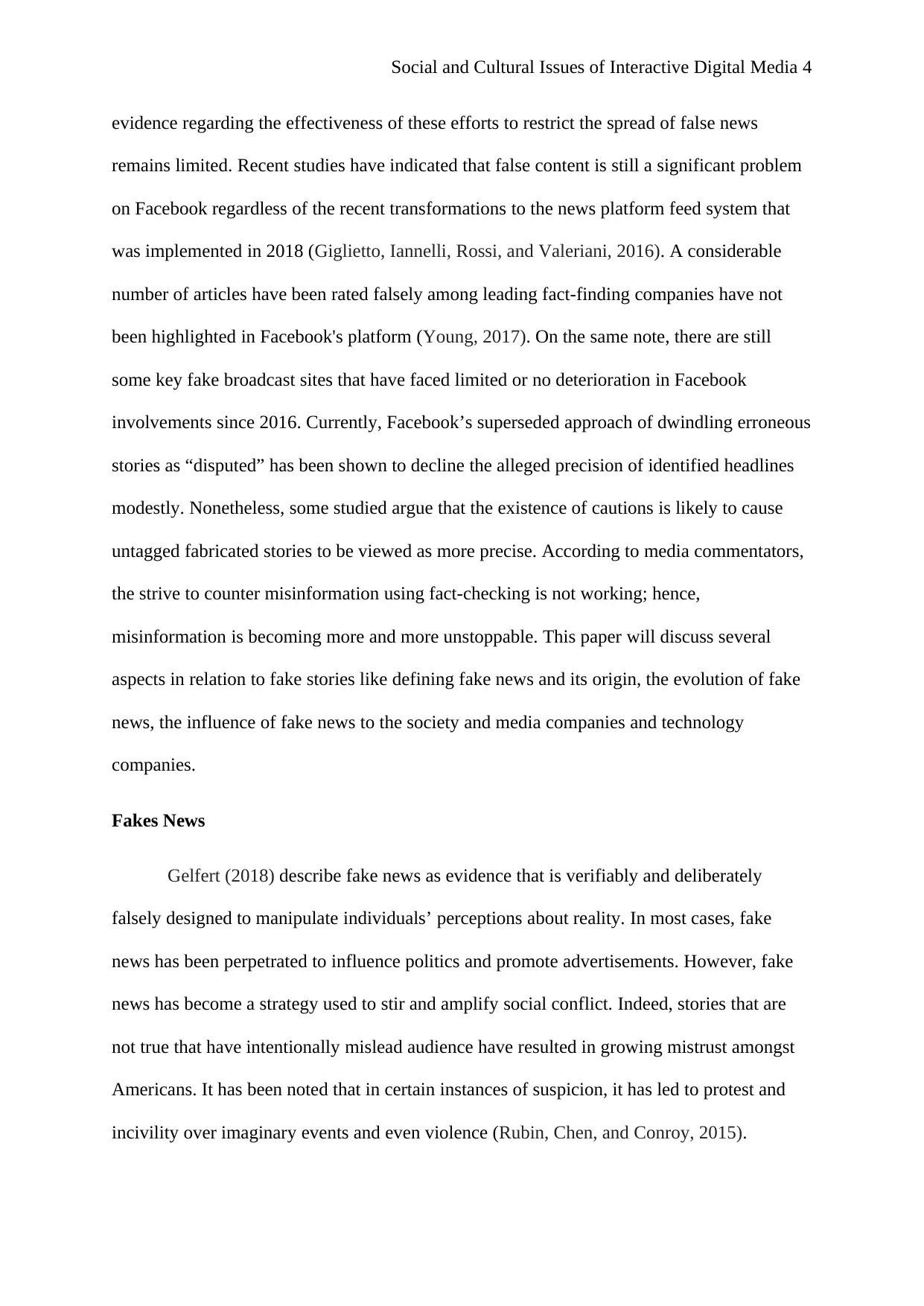
Social and Cultural Issues of Interactive Digital Media 4
evidence regarding the effectiveness of these efforts to restrict the spread of false news
remains limited. Recent studies have indicated that false content is still a significant problem
on Facebook regardless of the recent transformations to the news platform feed system that
was implemented in 2018 (Giglietto, Iannelli, Rossi, and Valeriani, 2016). A considerable
number of articles have been rated falsely among leading fact-finding companies have not
been highlighted in Facebook's platform (Young, 2017). On the same note, there are still
some key fake broadcast sites that have faced limited or no deterioration in Facebook
involvements since 2016. Currently, Facebook’s superseded approach of dwindling erroneous
stories as “disputed” has been shown to decline the alleged precision of identified headlines
modestly. Nonetheless, some studied argue that the existence of cautions is likely to cause
untagged fabricated stories to be viewed as more precise. According to media commentators,
the strive to counter misinformation using fact-checking is not working; hence,
misinformation is becoming more and more unstoppable. This paper will discuss several
aspects in relation to fake stories like defining fake news and its origin, the evolution of fake
news, the influence of fake news to the society and media companies and technology
companies.
Fakes News
Gelfert (2018) describe fake news as evidence that is verifiably and deliberately
falsely designed to manipulate individuals’ perceptions about reality. In most cases, fake
news has been perpetrated to influence politics and promote advertisements. However, fake
news has become a strategy used to stir and amplify social conflict. Indeed, stories that are
not true that have intentionally mislead audience have resulted in growing mistrust amongst
Americans. It has been noted that in certain instances of suspicion, it has led to protest and
incivility over imaginary events and even violence (Rubin, Chen, and Conroy, 2015).
evidence regarding the effectiveness of these efforts to restrict the spread of false news
remains limited. Recent studies have indicated that false content is still a significant problem
on Facebook regardless of the recent transformations to the news platform feed system that
was implemented in 2018 (Giglietto, Iannelli, Rossi, and Valeriani, 2016). A considerable
number of articles have been rated falsely among leading fact-finding companies have not
been highlighted in Facebook's platform (Young, 2017). On the same note, there are still
some key fake broadcast sites that have faced limited or no deterioration in Facebook
involvements since 2016. Currently, Facebook’s superseded approach of dwindling erroneous
stories as “disputed” has been shown to decline the alleged precision of identified headlines
modestly. Nonetheless, some studied argue that the existence of cautions is likely to cause
untagged fabricated stories to be viewed as more precise. According to media commentators,
the strive to counter misinformation using fact-checking is not working; hence,
misinformation is becoming more and more unstoppable. This paper will discuss several
aspects in relation to fake stories like defining fake news and its origin, the evolution of fake
news, the influence of fake news to the society and media companies and technology
companies.
Fakes News
Gelfert (2018) describe fake news as evidence that is verifiably and deliberately
falsely designed to manipulate individuals’ perceptions about reality. In most cases, fake
news has been perpetrated to influence politics and promote advertisements. However, fake
news has become a strategy used to stir and amplify social conflict. Indeed, stories that are
not true that have intentionally mislead audience have resulted in growing mistrust amongst
Americans. It has been noted that in certain instances of suspicion, it has led to protest and
incivility over imaginary events and even violence (Rubin, Chen, and Conroy, 2015).
Paraphrase This Document
Need a fresh take? Get an instant paraphrase of this document with our AI Paraphraser
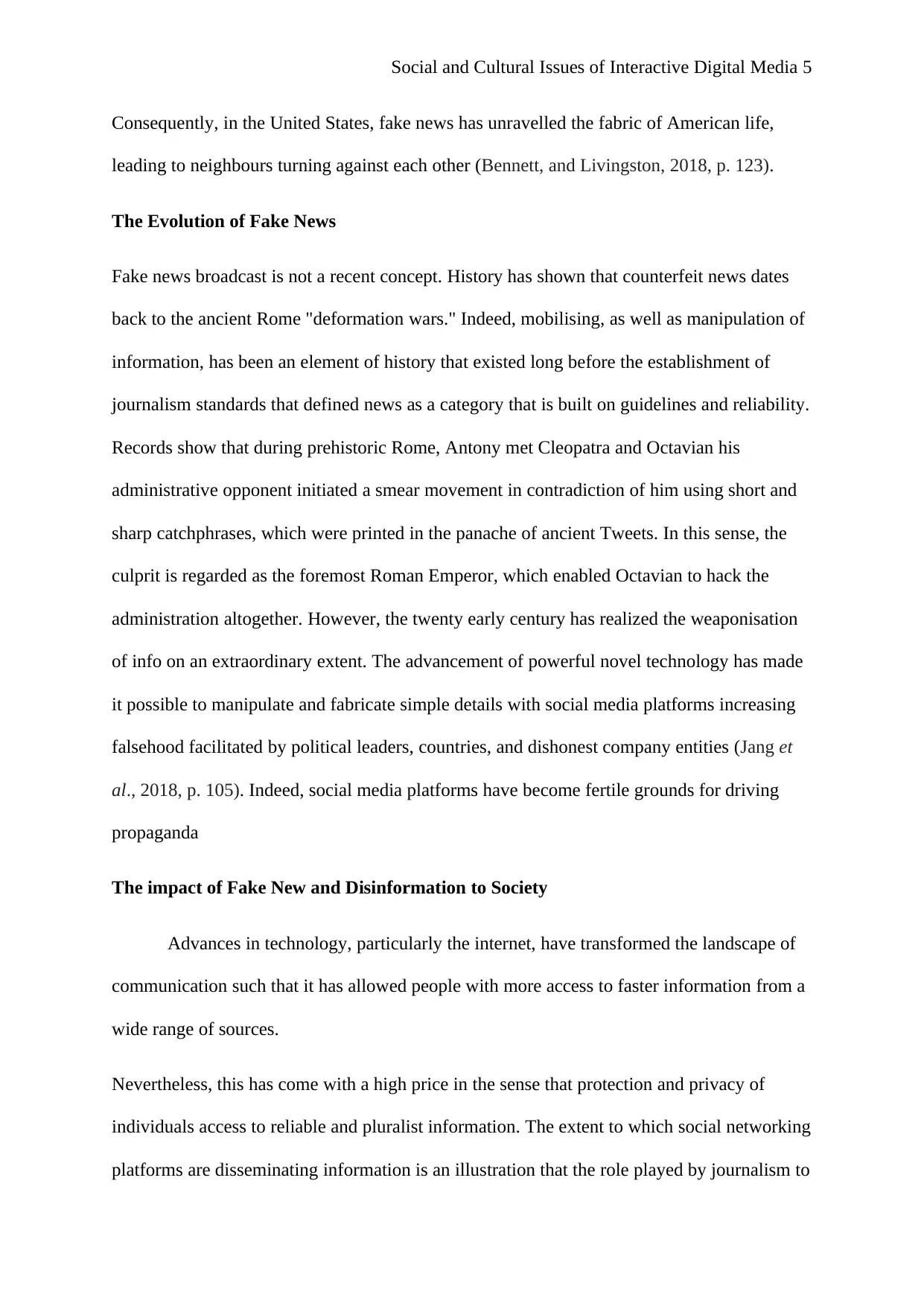
Social and Cultural Issues of Interactive Digital Media 5
Consequently, in the United States, fake news has unravelled the fabric of American life,
leading to neighbours turning against each other (Bennett, and Livingston, 2018, p. 123).
The Evolution of Fake News
Fake news broadcast is not a recent concept. History has shown that counterfeit news dates
back to the ancient Rome "deformation wars." Indeed, mobilising, as well as manipulation of
information, has been an element of history that existed long before the establishment of
journalism standards that defined news as a category that is built on guidelines and reliability.
Records show that during prehistoric Rome, Antony met Cleopatra and Octavian his
administrative opponent initiated a smear movement in contradiction of him using short and
sharp catchphrases, which were printed in the panache of ancient Tweets. In this sense, the
culprit is regarded as the foremost Roman Emperor, which enabled Octavian to hack the
administration altogether. However, the twenty early century has realized the weaponisation
of info on an extraordinary extent. The advancement of powerful novel technology has made
it possible to manipulate and fabricate simple details with social media platforms increasing
falsehood facilitated by political leaders, countries, and dishonest company entities (Jang et
al., 2018, p. 105). Indeed, social media platforms have become fertile grounds for driving
propaganda
The impact of Fake New and Disinformation to Society
Advances in technology, particularly the internet, have transformed the landscape of
communication such that it has allowed people with more access to faster information from a
wide range of sources.
Nevertheless, this has come with a high price in the sense that protection and privacy of
individuals access to reliable and pluralist information. The extent to which social networking
platforms are disseminating information is an illustration that the role played by journalism to
Consequently, in the United States, fake news has unravelled the fabric of American life,
leading to neighbours turning against each other (Bennett, and Livingston, 2018, p. 123).
The Evolution of Fake News
Fake news broadcast is not a recent concept. History has shown that counterfeit news dates
back to the ancient Rome "deformation wars." Indeed, mobilising, as well as manipulation of
information, has been an element of history that existed long before the establishment of
journalism standards that defined news as a category that is built on guidelines and reliability.
Records show that during prehistoric Rome, Antony met Cleopatra and Octavian his
administrative opponent initiated a smear movement in contradiction of him using short and
sharp catchphrases, which were printed in the panache of ancient Tweets. In this sense, the
culprit is regarded as the foremost Roman Emperor, which enabled Octavian to hack the
administration altogether. However, the twenty early century has realized the weaponisation
of info on an extraordinary extent. The advancement of powerful novel technology has made
it possible to manipulate and fabricate simple details with social media platforms increasing
falsehood facilitated by political leaders, countries, and dishonest company entities (Jang et
al., 2018, p. 105). Indeed, social media platforms have become fertile grounds for driving
propaganda
The impact of Fake New and Disinformation to Society
Advances in technology, particularly the internet, have transformed the landscape of
communication such that it has allowed people with more access to faster information from a
wide range of sources.
Nevertheless, this has come with a high price in the sense that protection and privacy of
individuals access to reliable and pluralist information. The extent to which social networking
platforms are disseminating information is an illustration that the role played by journalism to
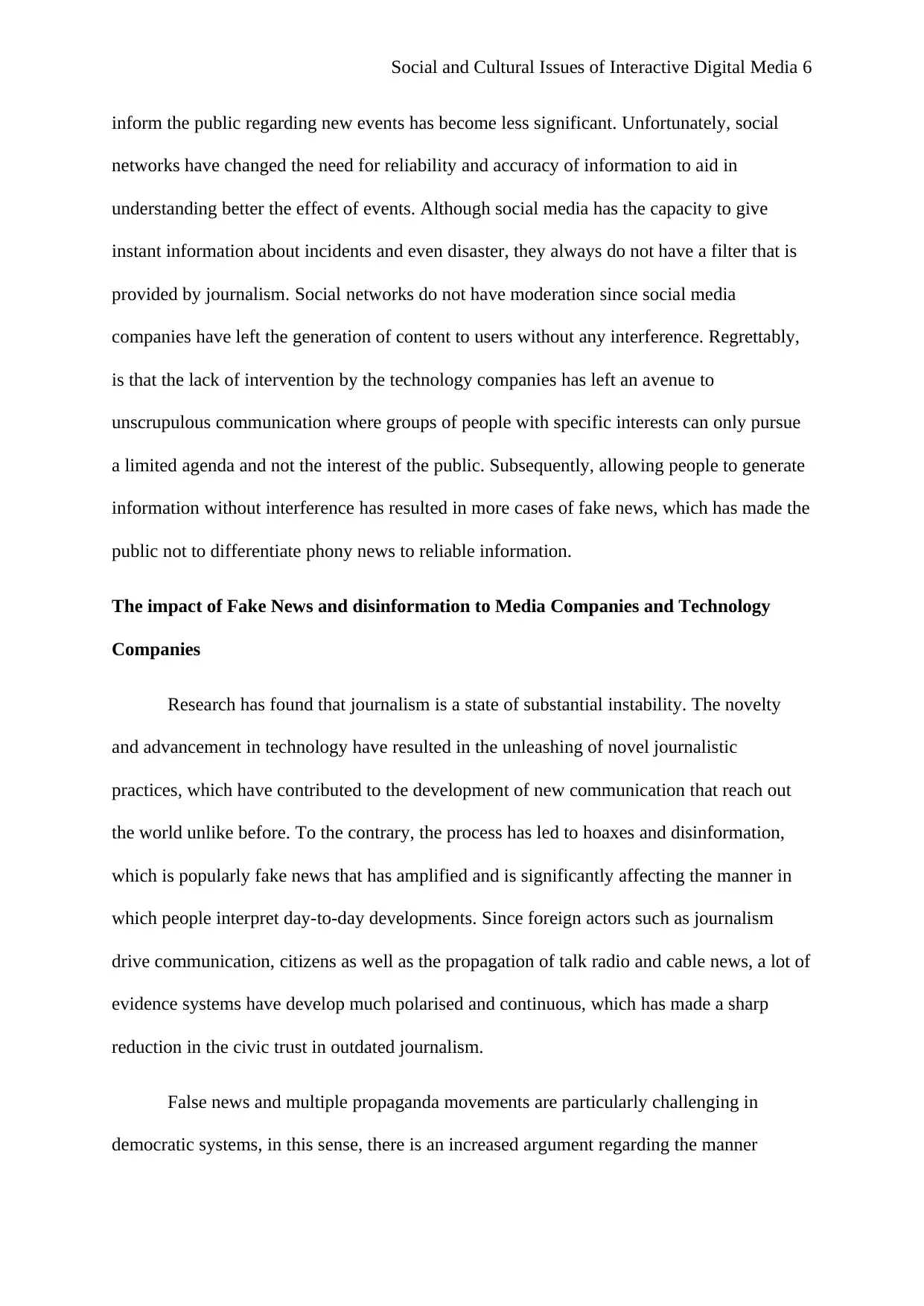
Social and Cultural Issues of Interactive Digital Media 6
inform the public regarding new events has become less significant. Unfortunately, social
networks have changed the need for reliability and accuracy of information to aid in
understanding better the effect of events. Although social media has the capacity to give
instant information about incidents and even disaster, they always do not have a filter that is
provided by journalism. Social networks do not have moderation since social media
companies have left the generation of content to users without any interference. Regrettably,
is that the lack of intervention by the technology companies has left an avenue to
unscrupulous communication where groups of people with specific interests can only pursue
a limited agenda and not the interest of the public. Subsequently, allowing people to generate
information without interference has resulted in more cases of fake news, which has made the
public not to differentiate phony news to reliable information.
The impact of Fake News and disinformation to Media Companies and Technology
Companies
Research has found that journalism is a state of substantial instability. The novelty
and advancement in technology have resulted in the unleashing of novel journalistic
practices, which have contributed to the development of new communication that reach out
the world unlike before. To the contrary, the process has led to hoaxes and disinformation,
which is popularly fake news that has amplified and is significantly affecting the manner in
which people interpret day-to-day developments. Since foreign actors such as journalism
drive communication, citizens as well as the propagation of talk radio and cable news, a lot of
evidence systems have develop much polarised and continuous, which has made a sharp
reduction in the civic trust in outdated journalism.
False news and multiple propaganda movements are particularly challenging in
democratic systems, in this sense, there is an increased argument regarding the manner
inform the public regarding new events has become less significant. Unfortunately, social
networks have changed the need for reliability and accuracy of information to aid in
understanding better the effect of events. Although social media has the capacity to give
instant information about incidents and even disaster, they always do not have a filter that is
provided by journalism. Social networks do not have moderation since social media
companies have left the generation of content to users without any interference. Regrettably,
is that the lack of intervention by the technology companies has left an avenue to
unscrupulous communication where groups of people with specific interests can only pursue
a limited agenda and not the interest of the public. Subsequently, allowing people to generate
information without interference has resulted in more cases of fake news, which has made the
public not to differentiate phony news to reliable information.
The impact of Fake News and disinformation to Media Companies and Technology
Companies
Research has found that journalism is a state of substantial instability. The novelty
and advancement in technology have resulted in the unleashing of novel journalistic
practices, which have contributed to the development of new communication that reach out
the world unlike before. To the contrary, the process has led to hoaxes and disinformation,
which is popularly fake news that has amplified and is significantly affecting the manner in
which people interpret day-to-day developments. Since foreign actors such as journalism
drive communication, citizens as well as the propagation of talk radio and cable news, a lot of
evidence systems have develop much polarised and continuous, which has made a sharp
reduction in the civic trust in outdated journalism.
False news and multiple propaganda movements are particularly challenging in
democratic systems, in this sense, there is an increased argument regarding the manner
⊘ This is a preview!⊘
Do you want full access?
Subscribe today to unlock all pages.

Trusted by 1+ million students worldwide
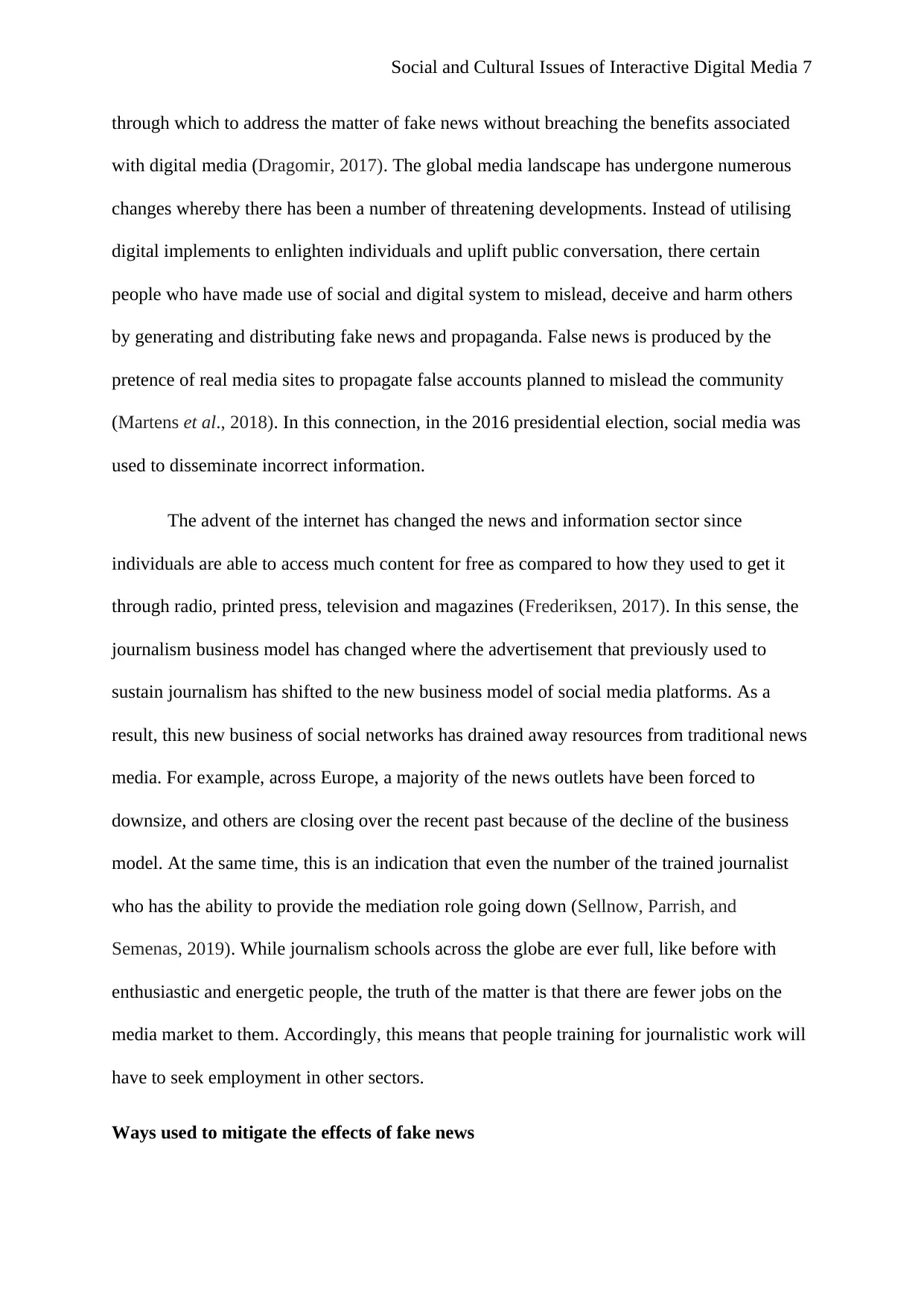
Social and Cultural Issues of Interactive Digital Media 7
through which to address the matter of fake news without breaching the benefits associated
with digital media (Dragomir, 2017). The global media landscape has undergone numerous
changes whereby there has been a number of threatening developments. Instead of utilising
digital implements to enlighten individuals and uplift public conversation, there certain
people who have made use of social and digital system to mislead, deceive and harm others
by generating and distributing fake news and propaganda. False news is produced by the
pretence of real media sites to propagate false accounts planned to mislead the community
(Martens et al., 2018). In this connection, in the 2016 presidential election, social media was
used to disseminate incorrect information.
The advent of the internet has changed the news and information sector since
individuals are able to access much content for free as compared to how they used to get it
through radio, printed press, television and magazines (Frederiksen, 2017). In this sense, the
journalism business model has changed where the advertisement that previously used to
sustain journalism has shifted to the new business model of social media platforms. As a
result, this new business of social networks has drained away resources from traditional news
media. For example, across Europe, a majority of the news outlets have been forced to
downsize, and others are closing over the recent past because of the decline of the business
model. At the same time, this is an indication that even the number of the trained journalist
who has the ability to provide the mediation role going down (Sellnow, Parrish, and
Semenas, 2019). While journalism schools across the globe are ever full, like before with
enthusiastic and energetic people, the truth of the matter is that there are fewer jobs on the
media market to them. Accordingly, this means that people training for journalistic work will
have to seek employment in other sectors.
Ways used to mitigate the effects of fake news
through which to address the matter of fake news without breaching the benefits associated
with digital media (Dragomir, 2017). The global media landscape has undergone numerous
changes whereby there has been a number of threatening developments. Instead of utilising
digital implements to enlighten individuals and uplift public conversation, there certain
people who have made use of social and digital system to mislead, deceive and harm others
by generating and distributing fake news and propaganda. False news is produced by the
pretence of real media sites to propagate false accounts planned to mislead the community
(Martens et al., 2018). In this connection, in the 2016 presidential election, social media was
used to disseminate incorrect information.
The advent of the internet has changed the news and information sector since
individuals are able to access much content for free as compared to how they used to get it
through radio, printed press, television and magazines (Frederiksen, 2017). In this sense, the
journalism business model has changed where the advertisement that previously used to
sustain journalism has shifted to the new business model of social media platforms. As a
result, this new business of social networks has drained away resources from traditional news
media. For example, across Europe, a majority of the news outlets have been forced to
downsize, and others are closing over the recent past because of the decline of the business
model. At the same time, this is an indication that even the number of the trained journalist
who has the ability to provide the mediation role going down (Sellnow, Parrish, and
Semenas, 2019). While journalism schools across the globe are ever full, like before with
enthusiastic and energetic people, the truth of the matter is that there are fewer jobs on the
media market to them. Accordingly, this means that people training for journalistic work will
have to seek employment in other sectors.
Ways used to mitigate the effects of fake news
Paraphrase This Document
Need a fresh take? Get an instant paraphrase of this document with our AI Paraphraser
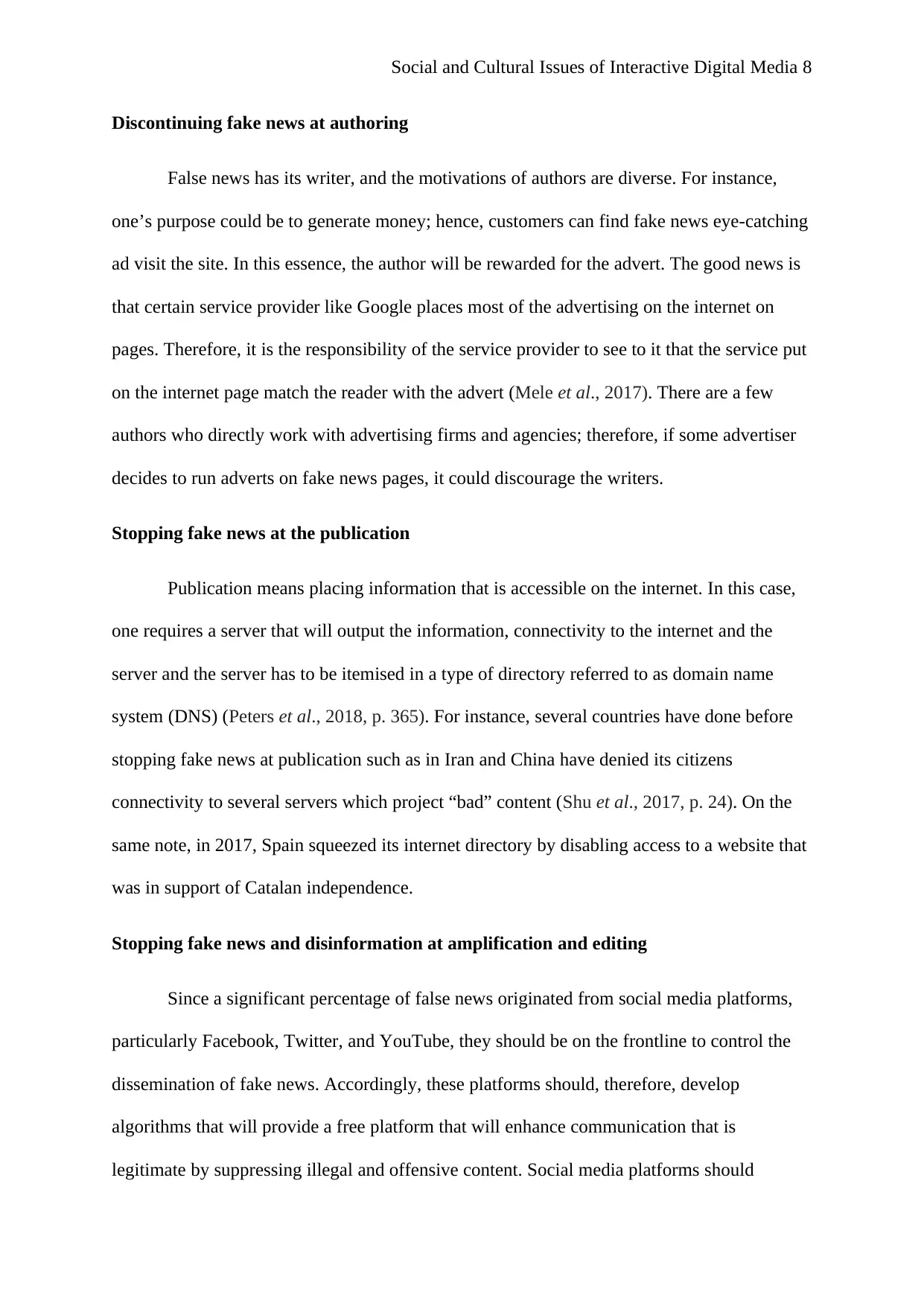
Social and Cultural Issues of Interactive Digital Media 8
Discontinuing fake news at authoring
False news has its writer, and the motivations of authors are diverse. For instance,
one’s purpose could be to generate money; hence, customers can find fake news eye-catching
ad visit the site. In this essence, the author will be rewarded for the advert. The good news is
that certain service provider like Google places most of the advertising on the internet on
pages. Therefore, it is the responsibility of the service provider to see to it that the service put
on the internet page match the reader with the advert (Mele et al., 2017). There are a few
authors who directly work with advertising firms and agencies; therefore, if some advertiser
decides to run adverts on fake news pages, it could discourage the writers.
Stopping fake news at the publication
Publication means placing information that is accessible on the internet. In this case,
one requires a server that will output the information, connectivity to the internet and the
server and the server has to be itemised in a type of directory referred to as domain name
system (DNS) (Peters et al., 2018, p. 365). For instance, several countries have done before
stopping fake news at publication such as in Iran and China have denied its citizens
connectivity to several servers which project “bad” content (Shu et al., 2017, p. 24). On the
same note, in 2017, Spain squeezed its internet directory by disabling access to a website that
was in support of Catalan independence.
Stopping fake news and disinformation at amplification and editing
Since a significant percentage of false news originated from social media platforms,
particularly Facebook, Twitter, and YouTube, they should be on the frontline to control the
dissemination of fake news. Accordingly, these platforms should, therefore, develop
algorithms that will provide a free platform that will enhance communication that is
legitimate by suppressing illegal and offensive content. Social media platforms should
Discontinuing fake news at authoring
False news has its writer, and the motivations of authors are diverse. For instance,
one’s purpose could be to generate money; hence, customers can find fake news eye-catching
ad visit the site. In this essence, the author will be rewarded for the advert. The good news is
that certain service provider like Google places most of the advertising on the internet on
pages. Therefore, it is the responsibility of the service provider to see to it that the service put
on the internet page match the reader with the advert (Mele et al., 2017). There are a few
authors who directly work with advertising firms and agencies; therefore, if some advertiser
decides to run adverts on fake news pages, it could discourage the writers.
Stopping fake news at the publication
Publication means placing information that is accessible on the internet. In this case,
one requires a server that will output the information, connectivity to the internet and the
server and the server has to be itemised in a type of directory referred to as domain name
system (DNS) (Peters et al., 2018, p. 365). For instance, several countries have done before
stopping fake news at publication such as in Iran and China have denied its citizens
connectivity to several servers which project “bad” content (Shu et al., 2017, p. 24). On the
same note, in 2017, Spain squeezed its internet directory by disabling access to a website that
was in support of Catalan independence.
Stopping fake news and disinformation at amplification and editing
Since a significant percentage of false news originated from social media platforms,
particularly Facebook, Twitter, and YouTube, they should be on the frontline to control the
dissemination of fake news. Accordingly, these platforms should, therefore, develop
algorithms that will provide a free platform that will enhance communication that is
legitimate by suppressing illegal and offensive content. Social media platforms should
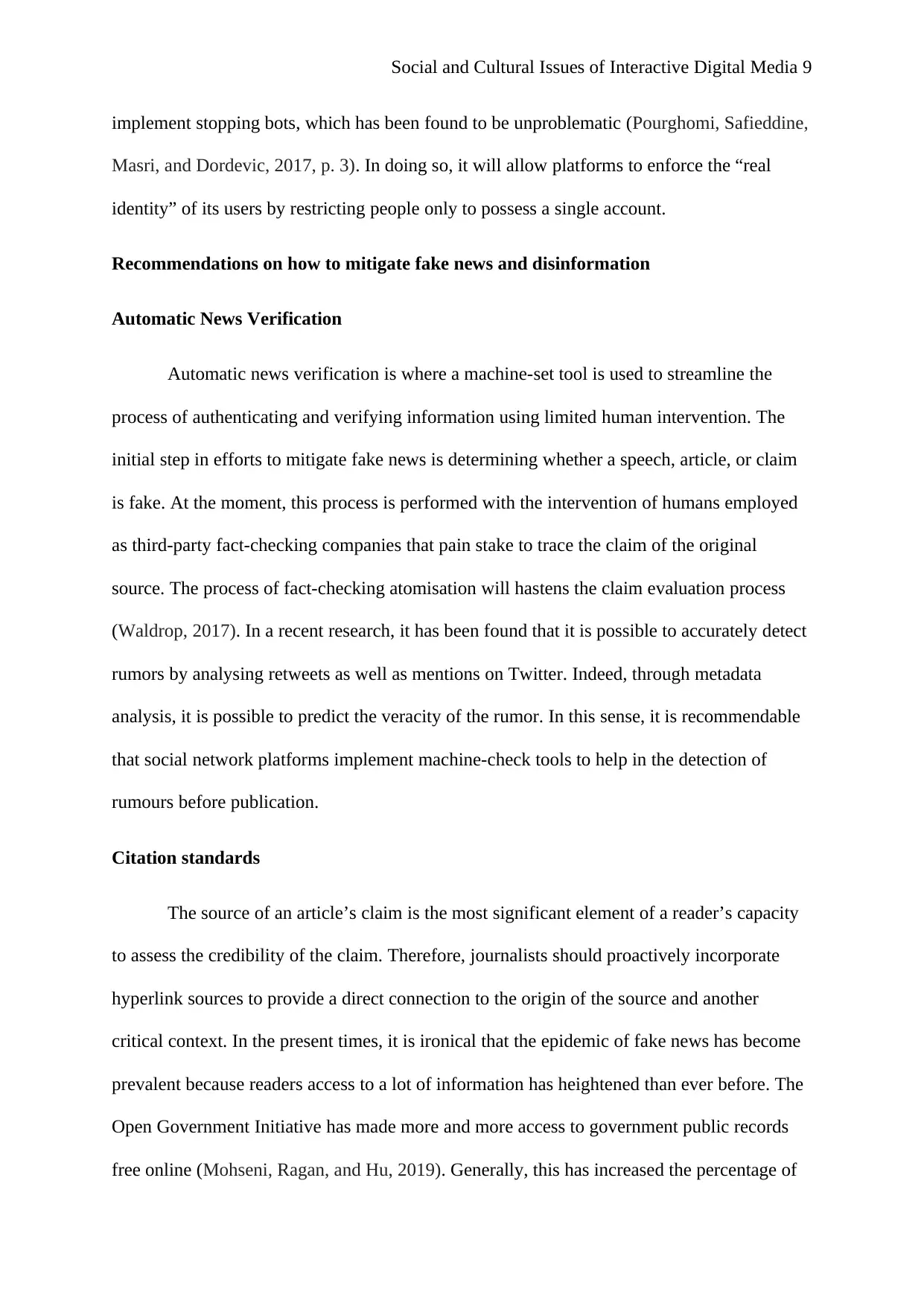
Social and Cultural Issues of Interactive Digital Media 9
implement stopping bots, which has been found to be unproblematic (Pourghomi, Safieddine,
Masri, and Dordevic, 2017, p. 3). In doing so, it will allow platforms to enforce the “real
identity” of its users by restricting people only to possess a single account.
Recommendations on how to mitigate fake news and disinformation
Automatic News Verification
Automatic news verification is where a machine-set tool is used to streamline the
process of authenticating and verifying information using limited human intervention. The
initial step in efforts to mitigate fake news is determining whether a speech, article, or claim
is fake. At the moment, this process is performed with the intervention of humans employed
as third-party fact-checking companies that pain stake to trace the claim of the original
source. The process of fact-checking atomisation will hastens the claim evaluation process
(Waldrop, 2017). In a recent research, it has been found that it is possible to accurately detect
rumors by analysing retweets as well as mentions on Twitter. Indeed, through metadata
analysis, it is possible to predict the veracity of the rumor. In this sense, it is recommendable
that social network platforms implement machine-check tools to help in the detection of
rumours before publication.
Citation standards
The source of an article’s claim is the most significant element of a reader’s capacity
to assess the credibility of the claim. Therefore, journalists should proactively incorporate
hyperlink sources to provide a direct connection to the origin of the source and another
critical context. In the present times, it is ironical that the epidemic of fake news has become
prevalent because readers access to a lot of information has heightened than ever before. The
Open Government Initiative has made more and more access to government public records
free online (Mohseni, Ragan, and Hu, 2019). Generally, this has increased the percentage of
implement stopping bots, which has been found to be unproblematic (Pourghomi, Safieddine,
Masri, and Dordevic, 2017, p. 3). In doing so, it will allow platforms to enforce the “real
identity” of its users by restricting people only to possess a single account.
Recommendations on how to mitigate fake news and disinformation
Automatic News Verification
Automatic news verification is where a machine-set tool is used to streamline the
process of authenticating and verifying information using limited human intervention. The
initial step in efforts to mitigate fake news is determining whether a speech, article, or claim
is fake. At the moment, this process is performed with the intervention of humans employed
as third-party fact-checking companies that pain stake to trace the claim of the original
source. The process of fact-checking atomisation will hastens the claim evaluation process
(Waldrop, 2017). In a recent research, it has been found that it is possible to accurately detect
rumors by analysing retweets as well as mentions on Twitter. Indeed, through metadata
analysis, it is possible to predict the veracity of the rumor. In this sense, it is recommendable
that social network platforms implement machine-check tools to help in the detection of
rumours before publication.
Citation standards
The source of an article’s claim is the most significant element of a reader’s capacity
to assess the credibility of the claim. Therefore, journalists should proactively incorporate
hyperlink sources to provide a direct connection to the origin of the source and another
critical context. In the present times, it is ironical that the epidemic of fake news has become
prevalent because readers access to a lot of information has heightened than ever before. The
Open Government Initiative has made more and more access to government public records
free online (Mohseni, Ragan, and Hu, 2019). Generally, this has increased the percentage of
⊘ This is a preview!⊘
Do you want full access?
Subscribe today to unlock all pages.

Trusted by 1+ million students worldwide
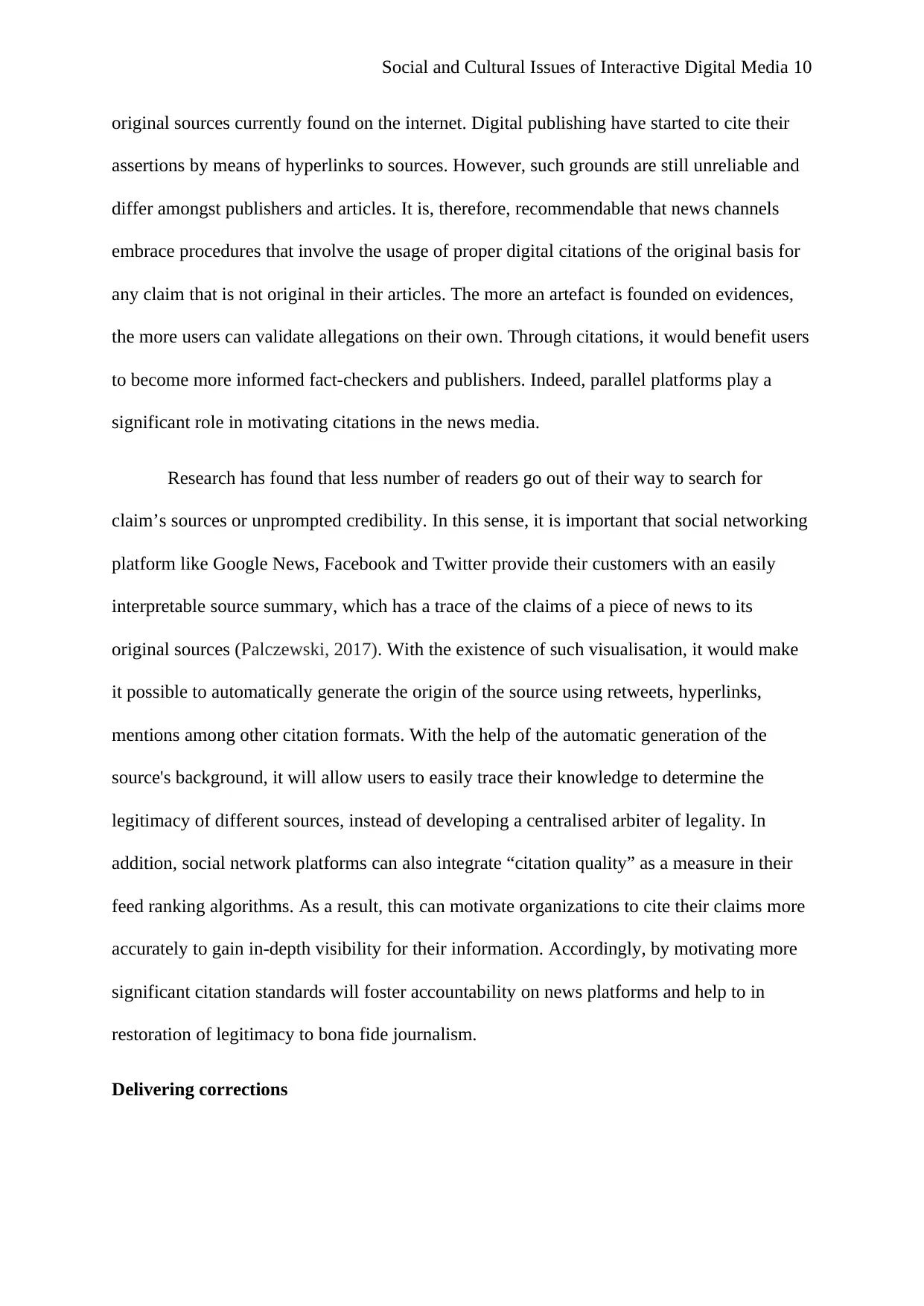
Social and Cultural Issues of Interactive Digital Media 10
original sources currently found on the internet. Digital publishing have started to cite their
assertions by means of hyperlinks to sources. However, such grounds are still unreliable and
differ amongst publishers and articles. It is, therefore, recommendable that news channels
embrace procedures that involve the usage of proper digital citations of the original basis for
any claim that is not original in their articles. The more an artefact is founded on evidences,
the more users can validate allegations on their own. Through citations, it would benefit users
to become more informed fact-checkers and publishers. Indeed, parallel platforms play a
significant role in motivating citations in the news media.
Research has found that less number of readers go out of their way to search for
claim’s sources or unprompted credibility. In this sense, it is important that social networking
platform like Google News, Facebook and Twitter provide their customers with an easily
interpretable source summary, which has a trace of the claims of a piece of news to its
original sources (Palczewski, 2017). With the existence of such visualisation, it would make
it possible to automatically generate the origin of the source using retweets, hyperlinks,
mentions among other citation formats. With the help of the automatic generation of the
source's background, it will allow users to easily trace their knowledge to determine the
legitimacy of different sources, instead of developing a centralised arbiter of legality. In
addition, social network platforms can also integrate “citation quality” as a measure in their
feed ranking algorithms. As a result, this can motivate organizations to cite their claims more
accurately to gain in-depth visibility for their information. Accordingly, by motivating more
significant citation standards will foster accountability on news platforms and help to in
restoration of legitimacy to bona fide journalism.
Delivering corrections
original sources currently found on the internet. Digital publishing have started to cite their
assertions by means of hyperlinks to sources. However, such grounds are still unreliable and
differ amongst publishers and articles. It is, therefore, recommendable that news channels
embrace procedures that involve the usage of proper digital citations of the original basis for
any claim that is not original in their articles. The more an artefact is founded on evidences,
the more users can validate allegations on their own. Through citations, it would benefit users
to become more informed fact-checkers and publishers. Indeed, parallel platforms play a
significant role in motivating citations in the news media.
Research has found that less number of readers go out of their way to search for
claim’s sources or unprompted credibility. In this sense, it is important that social networking
platform like Google News, Facebook and Twitter provide their customers with an easily
interpretable source summary, which has a trace of the claims of a piece of news to its
original sources (Palczewski, 2017). With the existence of such visualisation, it would make
it possible to automatically generate the origin of the source using retweets, hyperlinks,
mentions among other citation formats. With the help of the automatic generation of the
source's background, it will allow users to easily trace their knowledge to determine the
legitimacy of different sources, instead of developing a centralised arbiter of legality. In
addition, social network platforms can also integrate “citation quality” as a measure in their
feed ranking algorithms. As a result, this can motivate organizations to cite their claims more
accurately to gain in-depth visibility for their information. Accordingly, by motivating more
significant citation standards will foster accountability on news platforms and help to in
restoration of legitimacy to bona fide journalism.
Delivering corrections
Paraphrase This Document
Need a fresh take? Get an instant paraphrase of this document with our AI Paraphraser
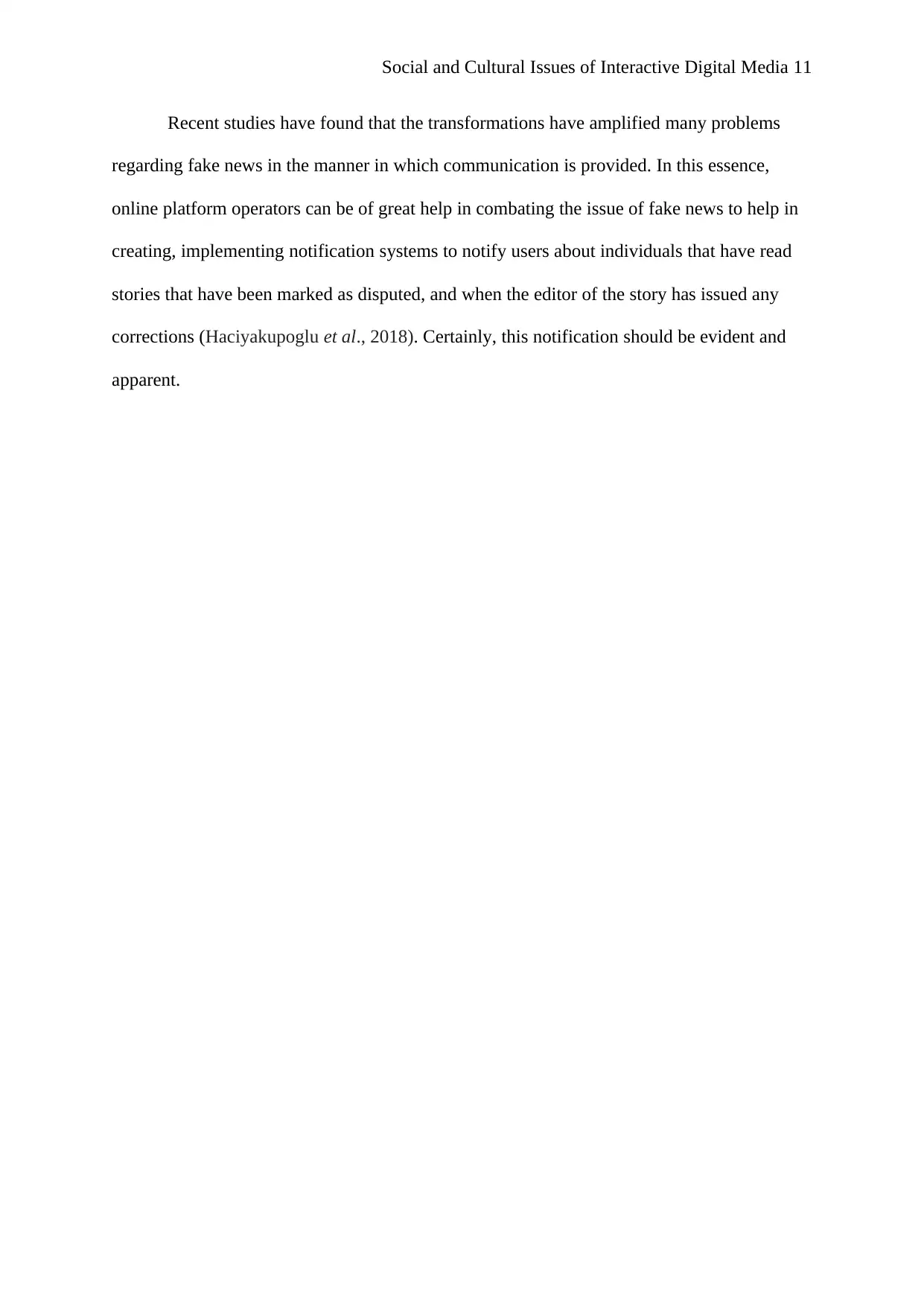
Social and Cultural Issues of Interactive Digital Media 11
Recent studies have found that the transformations have amplified many problems
regarding fake news in the manner in which communication is provided. In this essence,
online platform operators can be of great help in combating the issue of fake news to help in
creating, implementing notification systems to notify users about individuals that have read
stories that have been marked as disputed, and when the editor of the story has issued any
corrections (Haciyakupoglu et al., 2018). Certainly, this notification should be evident and
apparent.
Recent studies have found that the transformations have amplified many problems
regarding fake news in the manner in which communication is provided. In this essence,
online platform operators can be of great help in combating the issue of fake news to help in
creating, implementing notification systems to notify users about individuals that have read
stories that have been marked as disputed, and when the editor of the story has issued any
corrections (Haciyakupoglu et al., 2018). Certainly, this notification should be evident and
apparent.
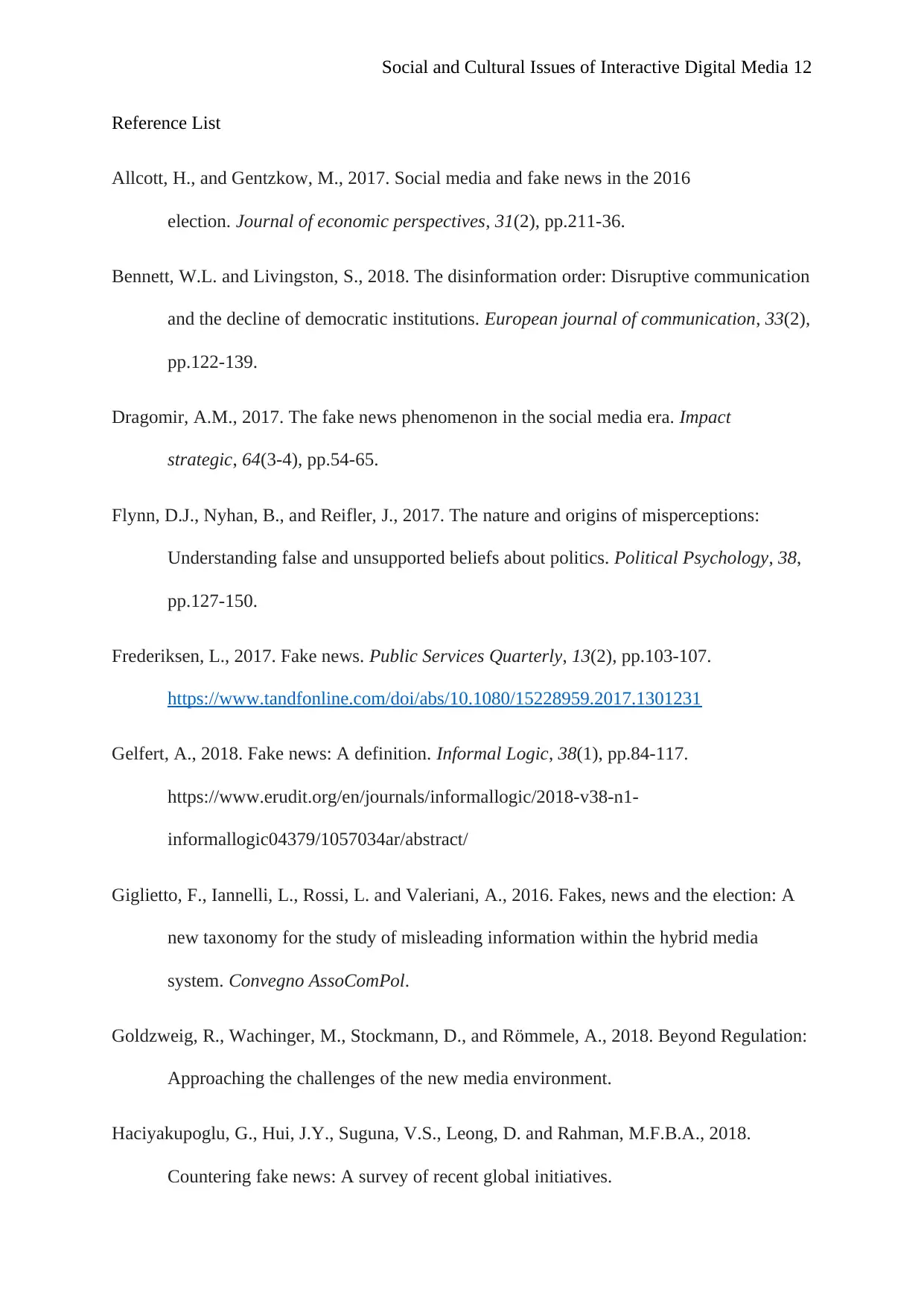
Social and Cultural Issues of Interactive Digital Media 12
Reference List
Allcott, H., and Gentzkow, M., 2017. Social media and fake news in the 2016
election. Journal of economic perspectives, 31(2), pp.211-36.
Bennett, W.L. and Livingston, S., 2018. The disinformation order: Disruptive communication
and the decline of democratic institutions. European journal of communication, 33(2),
pp.122-139.
Dragomir, A.M., 2017. The fake news phenomenon in the social media era. Impact
strategic, 64(3-4), pp.54-65.
Flynn, D.J., Nyhan, B., and Reifler, J., 2017. The nature and origins of misperceptions:
Understanding false and unsupported beliefs about politics. Political Psychology, 38,
pp.127-150.
Frederiksen, L., 2017. Fake news. Public Services Quarterly, 13(2), pp.103-107.
https://www.tandfonline.com/doi/abs/10.1080/15228959.2017.1301231
Gelfert, A., 2018. Fake news: A definition. Informal Logic, 38(1), pp.84-117.
https://www.erudit.org/en/journals/informallogic/2018-v38-n1-
informallogic04379/1057034ar/abstract/
Giglietto, F., Iannelli, L., Rossi, L. and Valeriani, A., 2016. Fakes, news and the election: A
new taxonomy for the study of misleading information within the hybrid media
system. Convegno AssoComPol.
Goldzweig, R., Wachinger, M., Stockmann, D., and Römmele, A., 2018. Beyond Regulation:
Approaching the challenges of the new media environment.
Haciyakupoglu, G., Hui, J.Y., Suguna, V.S., Leong, D. and Rahman, M.F.B.A., 2018.
Countering fake news: A survey of recent global initiatives.
Reference List
Allcott, H., and Gentzkow, M., 2017. Social media and fake news in the 2016
election. Journal of economic perspectives, 31(2), pp.211-36.
Bennett, W.L. and Livingston, S., 2018. The disinformation order: Disruptive communication
and the decline of democratic institutions. European journal of communication, 33(2),
pp.122-139.
Dragomir, A.M., 2017. The fake news phenomenon in the social media era. Impact
strategic, 64(3-4), pp.54-65.
Flynn, D.J., Nyhan, B., and Reifler, J., 2017. The nature and origins of misperceptions:
Understanding false and unsupported beliefs about politics. Political Psychology, 38,
pp.127-150.
Frederiksen, L., 2017. Fake news. Public Services Quarterly, 13(2), pp.103-107.
https://www.tandfonline.com/doi/abs/10.1080/15228959.2017.1301231
Gelfert, A., 2018. Fake news: A definition. Informal Logic, 38(1), pp.84-117.
https://www.erudit.org/en/journals/informallogic/2018-v38-n1-
informallogic04379/1057034ar/abstract/
Giglietto, F., Iannelli, L., Rossi, L. and Valeriani, A., 2016. Fakes, news and the election: A
new taxonomy for the study of misleading information within the hybrid media
system. Convegno AssoComPol.
Goldzweig, R., Wachinger, M., Stockmann, D., and Römmele, A., 2018. Beyond Regulation:
Approaching the challenges of the new media environment.
Haciyakupoglu, G., Hui, J.Y., Suguna, V.S., Leong, D. and Rahman, M.F.B.A., 2018.
Countering fake news: A survey of recent global initiatives.
⊘ This is a preview!⊘
Do you want full access?
Subscribe today to unlock all pages.

Trusted by 1+ million students worldwide
1 out of 14
Related Documents
Your All-in-One AI-Powered Toolkit for Academic Success.
+13062052269
info@desklib.com
Available 24*7 on WhatsApp / Email
![[object Object]](/_next/static/media/star-bottom.7253800d.svg)
Unlock your academic potential
Copyright © 2020–2025 A2Z Services. All Rights Reserved. Developed and managed by ZUCOL.





